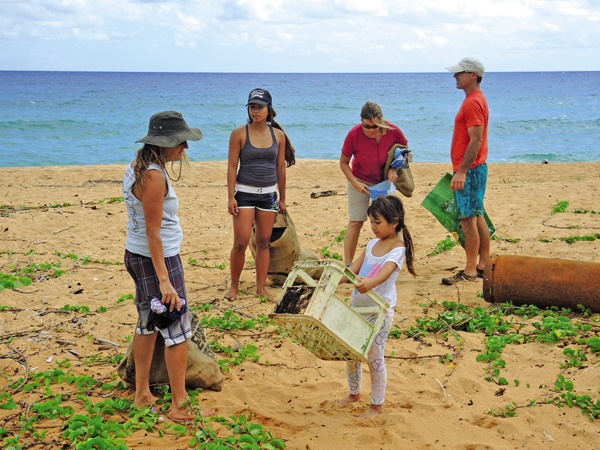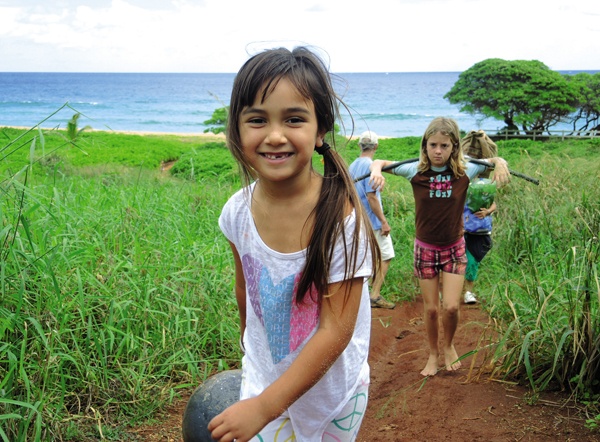KAPAA — Five-year-old Lehua Wetzel first said she helped clean up Donkey Beach because she came along with her mother. But she had a second reason for picking up nets and other marine debris washed up on this pristine spot.
KAPAA — Five-year-old Lehua Wetzel first said she helped clean up Donkey Beach because she came along with her mother.
But she had a second reason for picking up nets and other marine debris washed up on this pristine spot.
“Cause the animals don’t eat plastic,” she said, with a smile
More than 20 months after a tsunami killed scores in Japan and spread an untold amount of debris into the Pacific Ocean, Kauai is still cleaning up debris making its way to local beaches.
On Saturday, it was Donkey Beach’s turn to be hit by volunteers. About 20 people showed up at this popular Eastside beach for an event organized by the Surfrider Foundation Kauai Chapter.
“Once a month, we have been doing a Japan tsunami debris cleanup,” said Robert Zelkosky, chair of Kauai’s chapter of the Surfrider.
He added the funding for the cleanups came from a grant from the state Department of Health. The money pays for a truck rental, scholarships for two Kauai Community College students who do data monitoring and for advertisement.
The step-up in advertisement, as well as emails and more aggressive social media has been paying off. On Saturday, there were about 15 people who came for the first time, according to Zelkosky.
Surfrider member and former chair Carl Berg was weighing derelict fish nets and debris before throwing them into the bed of a pickup truck.
By 11 a.m., Berg had already weighed 413 pounds of fishnets, and there was more to come. The majority of those nets — 371 pounds — had been picked up earlier that morning at the shoreline facing Pono Kai Resort, just a few miles south.
“My job is to pick up all this stuff and take it to Restore Kauai,” he said of the fishnets.
By the time the cleanup had wrapped up, Berg said volunteers had picked up 499.5 pounds of garbage, including a large propane tank, and 73.9 pounds of derelict fishnets from Donkey Beach.
Once a year, the nets are shipped to Oahu, thanks to free freight and a $1,000 grant from Matson, and burned up by Honolulu’s H-Power to generate electricity, Berg said.
“It’s off our beaches and off our island,” he said.
About 8.6 tons of fishnets have been shipped to Oahu this year, according to Berg.
The Donkey Beach cleanup was the fifth in a series of 11 allowed by the grant.
Lihue resident Scott McCubbins said he participated in all of them, and plans to keep coming back.
“It’s to protect marine life, that’s why we do this,” he said.
Hannah Asquith, 10, said she wants to help the animals and the ocean. She said she had the most fun when she saw everybody cleaning up the beach.
Her mother, Bonnie Asquith, used to help in beach cleanups along with her husband years ago. Now that their children are a bit grown up, they are back at it — with reinforcements.
“We wanted to participate as a family,” she said. “We live on the Eastside and we use all the beaches here.”
The next cleanup is Dec. 28 at Kealia Beach, and the Asquith family will be there again, she said.
Surfrider provides gloves, reusable burlap bags, lots of make-shift tools fitted with screens to make pick up easier, and refreshments and food, which were donated by Papaya’s and Java Kai.
Besides the Japan Tsunami Marine Debris Project, Surfrider organizes regular monthly beach cleanups and three to four fishnet cleanups each month.
Visit kauai.surfrider.org for more information.
• Léo Azambuja, staff writer, can be reached at 245-0452 or lazambuja@thegardenisland.com



